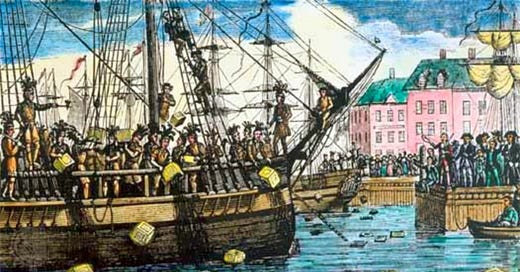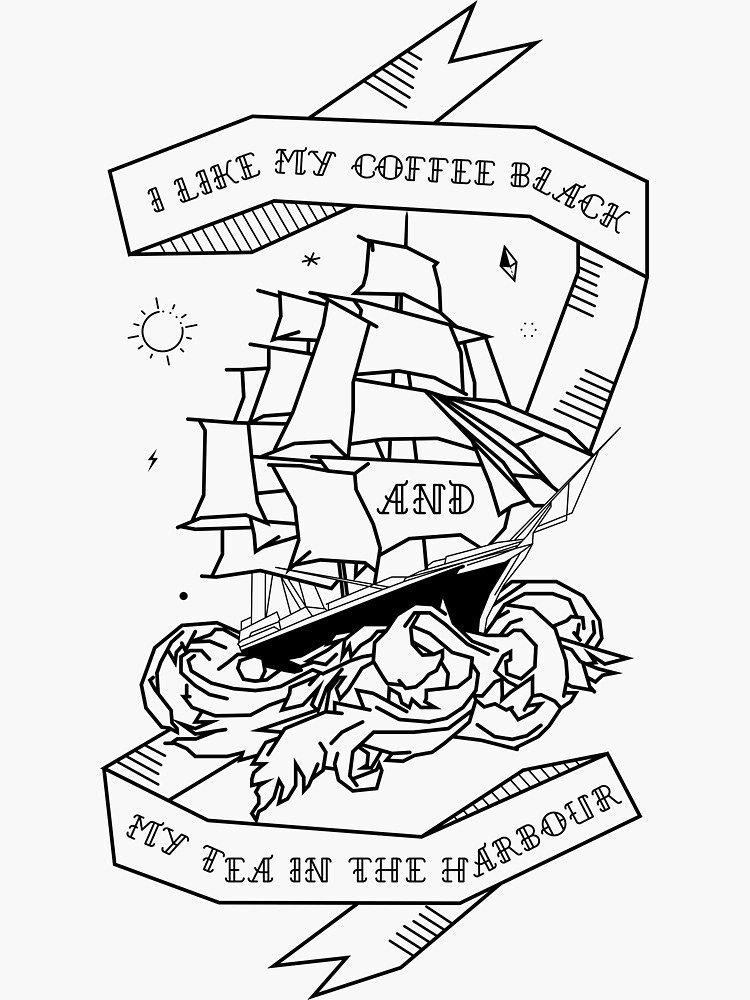Ask anyone familiar with American history what happened today, December 16th, and they will likely regale you with tales of 1773’s Boston Tea Party … when the Sons of Liberty disguised themselves as native Americans and dumped 4 shiploads of tea into Boston Harbor. They may even tell you that they did so to protest the British tax on tea … which is true, but not accurate. The British had actually lowered the tax on tea to undercut American tea smugglers (like John Hancock) and to dump a surplus of tea on the colonies. But the Tea Party was not protesting the amount of the tax, rather the right of Britain to tax the colonies at all without colonial representation.
What is often overlooked about the Boston Tea Party is that it was not an isolated incident, but one of several “Tea Party protests” in the colonies … and it wasn’t even the first one. So, instead of focusing on today’s party in Boston, with which you are likely familiar, let’s look at the Tea Party protest movement.
The first Tea Party took place 13 days earlier in Charleston, South Carolina … also led by the Sons of Liberty. This protest was organized by Christopher Gadsden, designer of the famous “Don’t Tread on Me” Gadsden flag. The protesters seized tea that had been shipped from Britain and left it to rot in a warehouse, beginning the colonial boycott. Closer to Boston, a second Tea Party took place 9 days later in Lexington, Massachusetts, where the first shots of the revolution would be fired a year and a half later. This Tea Party involved a citizen’s resolution against drinking tea and publicly burning the tea that they had on hand. The famous Boston Tea Party took place 4 days later … making it the third Tea Party protest.
But Boston was not the last Tea Party … the protests were just getting started. Over the course of the next year there would be at least 14 more. A few days after the Boston party, Philadelphia took on the largest shipment of tea … 697 chests weighing 260 pounds each … and in true Philly fashion opted for a more direct approach. A group of patriots calling themselves the “Committee for Tarring and Feathering” met the ship at the dock to inform the captain what would happen if the tea was unloaded. The wise captain turned the ship around and took the tea back to England.
On the final day of 1773, a merchant in Provincetown, Massachusetts bought three chests of newly arrived tea. Seven “mohawk Indians” (disguised Sons of Liberty) paid him a visit and burned the tea.
Students even got in on the tea parties. In January of 1774, students at the College of New Jersey (today’s Princeton) broke into a college storeroom and set aflame all the tea they could find. Next came April’s New York/Sandy Hook tea party, where the captain and crew of a ship carrying a large shipment of tea were seized when they docked at Sandy Hook. The crew was held hostage while the captain was taken to New York to be informed that his choice was take the tea back to England or be put to death. The tea went back to England. A few days later another ship arrived in New York, but the captain claimed there was no tea on board. The Sons of Liberty didn’t believe him and held him captive while they searched the ship. Onboard they found 18 chests of tea, which they unceremoniously dumped into the Hudson River.
On March 6th, Boston held a second tea party, this time a crowd of 60 boarded a ship and added 28 more chests of tea to Boston harbor.
No hard evidence exists that the next tea party actually occurred, but it’s believed that the citizens of Chestertown, Maryland dumped a shipload of tea into the Chester River on May 13th. The town did pass resolves against the importation of tea … and Chestertown still celebrates its apocryphal tea party annually. This was followed in early April by an all-female burning of tea in Wilmington, South Carolina. In July, Charleston, South Carolina held its 2nd tea party, but it is unclear what happened to the tea. In September, York, Maine (part of Massachusetts at the time) held a tea party when “Pickwacket Indians” stole a shipload of tea, but the disguised colonist likely consumed the booty.
Annapolis, Maryland then held one of the more violent tea parties in October when the Peggy Stewart arrived with a shipload of tea. The citizens of Annapolis forced the owner of the vessel to burn the tea … and the ship. Later that month, another all-female tea party was held in Edenton, North Carolina, but there was no seizure of tea. Instead, 51 women staged a protest against British tea. Charleston, South Carolina then outdid Boston with a third tea party. Seven more chests of tea ended up in the harbor. Yorktown, Virginia … where Cornwallis would eventually surrender, held a small tea party in November. Two chests of tea were dumped in the York River. The last recorded tea party was held in Greenwich, New Jersey, when locals seized a shipload of tea and burned it in the town square.
None of these events were called tea parties at the time, but in the 1830’s, as historians were preserving the history of the revolution, they began to refer to them as the “Tea Party Protests.” Collectively they destroyed hundreds of thousands of pounds of tea worth multiple millions of dollars, and though bloodshed was often threatened, only property damage occurred. These “mostly peaceful” protests let the King know that when the colonists said, “no taxation without representation,” they meant it.
NEXT WEEK: Return of the Pueblo’s crew






